2013 KCSE Business Studies Past Paper
4.6.1 Business Studies Paper l (565/1)
1. Outline four ways in which business studies may be of benefit to an individual. (4 marks)
2. Highlight four extemal factors that may negatively influence the operations of a business. (4 marks)
3. State four characteristics of a successful entrepreneur. (4 marks)
4. State four fiinctions of an office. (4 marks)
5. Fill the relevant branches of trade in the diagram given below: (3 marks)
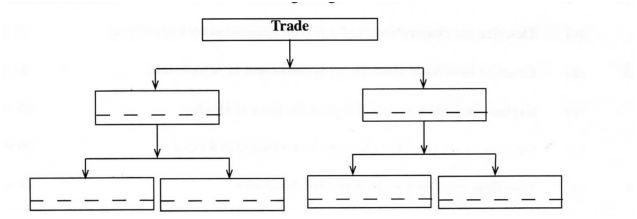
6 .The participants in a two sector economy are households and firms. Identify the relevant participant in each of the statements given below: (4 marks)

7. The following balances were extracted from the books of Wekesa Traders on 31*‘ December,2009.
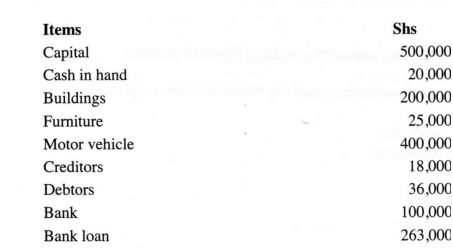
Using the above information, prepare Wekesa Tracler‘s Trial Balance on 315‘ December, 2009.
8. The following information relates to Karibu traders for the year ended 31“ December 2008.

Determine owner’s capital using the information given above. ‘ (4 marks)
9. State the type of unemployment relating to each of the following descriptions: (4 marks)
(a) Caused by altemating trading pattems occurring at similar times.
(b)Arises where workers have more skills and higher qualifications than the job requirements.
(c)Arises out of a mismatch between the skills possessed by potential employees and the location of the jobs available.
(d)Arises when people are unwilling to take up jobs due to low pay.
10. Highlight four circumstances under which the capital of a business may change. (4 marks)
ll. Below are some entries in the cash book of Romano Traders for the month of July 2010.
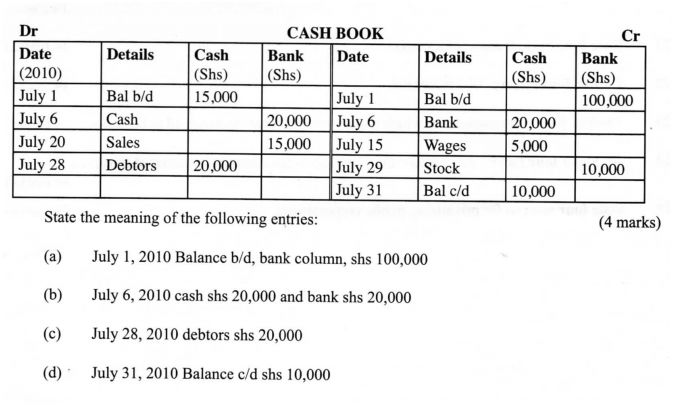
12. Outline one circumstance under which each of the following source documents may be issued by a trader: (4 marks)
(a) Debit note
………………………………………………………………………………………………………… ..
(b) Invoice
……………………………………………………………………………… —
(c) Credit note
……………………………………………………………………………………………………….. ..
(d) Quotation
…………………………………………………………………………………………………………. ..
13Name four documents that may be required by the registrar of companies in order to register a public limited company. (4 marks)
14. Outline four measures that a country can take to reduce the level of inflation. (4 marks)
15. Outline four factors that may make a producer to by-pass the wholesaler when distributing goods. (4 marks)
16. Highlight four benefits that a country would get by developing her infrastructure. (4 marks)
17. State four benefits of a bonded warehouse to the government. (4 marks)
18. Outline four qualities of a successful salesperson. (4 marks)
19. Highlight four factors that may cause the supply curve to shift to the right. (4 marks)
20. Outline four positive effects that production activities may have on community health. (4 marks)
21. State four basic features of a market. (4 marks)
22. Outline four features of a parastatal. (4 marks)
23. Outline four circumstances in which the govemment may be involved in business. (4 marks)
24. Highlight four factors that a trader may consider when choosing a means of transport. (4 marks)
25. State four reasons for privatizing public corporations. (4 marks)
4.6.2 Business Studies Paper 2 (565/2)
1.(a) Explain five benefits that may accrue to a country with a large proportion of skilled labour force. ( 10 marks)
(b) Outline five characteristics of an efficient tax system. (10 marks)
2. (a) Explain five benefits that Kenya may get as a member of C .O .M.E.S .A. (10 marks)
(b) Explain five factors that may hinder economic development in Kenya. (10 marks)
3. (a) Explain five benefits that may be realized by a country as a result of government policy to relocate industries to rural areas. (10 marks)
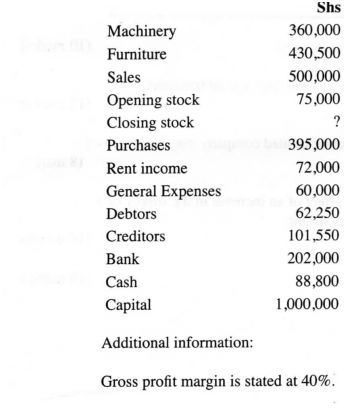
(b)The following balances were extracted from the books of Soilo Traders on 31“ December 2010.
4. (a) Explain five advantages of advertising to the consumer. (10 marks)
(b) On 1*‘ January 2011 ,Jumo Traders had shs 22,500 in cash and shs 250,000 at bank
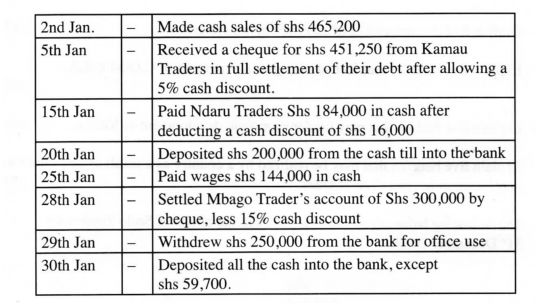
During the month, the following transactions took place:
Prepare a duly balanced three column cash book. (10 marks)
5.(a) Outline six circumstances under which a trader may use air transport.
(b) Explain four ways through which a public limited company may be dissolved
6.(a) With the aid of a diagram, explain the effect of an increase in the supply of a commodity while its demand remains constant.
(b) Explain five features of oligopoly. (10 marks)
2013 KCSE Business Studies Past Paper-Marking Scheme/Answers
5.6.1 Business Studies Paper 1 (565/ 1)
1. Ways in which Business Studies may benefit an individual include:
(a) Equips the individual with skills and knowledge to manage a business.
(b) Prepares one for future career in business.
(c) Enables one to relate issues affecting business to its environment.
(d) Enables one to relate issues affecting business activities taking place globally.
(e) Enables one to identify business opportunities to venture into.
(f) Prepares one for further studies.
(g) Enables an individual to think creatively and make sound judgement.
(h) Makes an individual to appreciate the role of govemment in business.
(i) Makes individual disciplined and have positive attitude towards work.
Any 4 x 1 = 4 marks
2.External factors that may influence the operations of a business negatively includes.
(a) Unfair competition.
(b) Inadequate technology.
(c) Unstable political environment.
(d) Unstable economic environment.
(e) Unfavourable legal framework.
(f) Unreliable supply system.
(g) Strong consumer bargaining power.
(h) Poor physical facilities and infrastructure.
(i) Low population level.
(j) Insecurity.
(k) Unfavourable socio-cultural environment.
(l) Natural calamities.
Any 4 x 1 = 4 marks
3. Characteristics of a successful entrepreneur include:-
(2.) Innovative and creative.
(b) Hardworking.
(c) Goal-oriented/desires to achieve.
(d) Time conscious.
(e) Self confident.
(f) Risk taker.
(g) Good decision maker.
(h) A good net worker.
(i) A good communicator.
(j) Should be ethical.
(k) Should be flexible.
(I) Future oriented.
Any 4 x 1 = 4 marks
4.Functions of the office include:
(a)Collecting information.
(b)Receiving information.
(c)Storing information.
(d)Distributing information.
(e)Production and reproduction of documents.
()Centre for administration.
(f)Mailing.
(g)Communication centre.
(h)safeguarding and controlling
Any 4 x 1 = 4 marks
5.
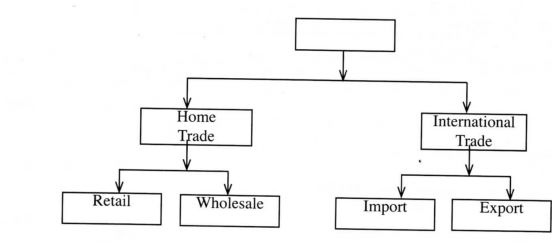
6.Households.
Households.
Firms.
Firms.
7.
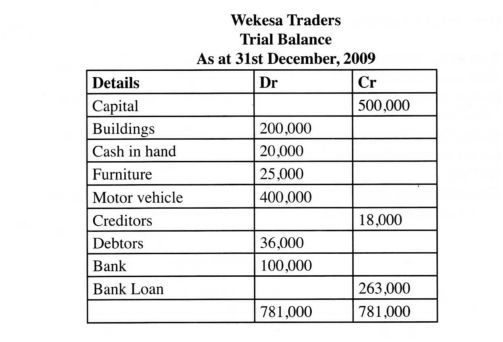
8.Determining owner’s capital.
C = A – L
= 2240.000 – 750.000
= 1.490.000
9. (a) Cyclical unemployment.
(b) Disguised/hidden unemployment.
(c) Structural unemployment/technological.
(d) Voluntary unemployment/real wage.
10. Circumstances under which the capital of a business may change are:-
(a) When the business makes profit.
(b) When the business makes losses.
(c) When the owner draws cash/goods for personal use/drawings.
(d) When the owner makes additional investment into the business/additional capital.
11.Meaning of the entries:
(a) Bank overdraft.
(b) Contra entry.
(c) Cash received from debtor.
(d) Closing cash in hand.
12. (a) When correcting undercharge.
(b)When demanding payment for goods supplied.
(c)When correcting an overcharge for goods supplied/empty packaging returned/ goods retumed.
(d) When replying to a specific letter of inquiry.
4 x 1 = 4 marks
13. Documents that may be required by the registrar of companies in order to register a public limited company include:-
(a) Articles of Association.
(b) Memorandum of Association.
(c) Prospectus.
(d)List of directors.
(e)Declaration.
(f)Statement signed by directors.
Any 4 x 1 = 4 marks
14.Measures that a country can take to reduce the level of inflation include:
(a) Increase income taxes to reduce the disposable income available to consumers.
(b) Reduce govemment expenditure.
(c)Introduce compulsory saving schemes like Pension Fund.
(d)Reduce exports.
(d) Enforce wage guidelines to control wage increase.
(f)Control prices by legislation.
(g)Increase interest rates on loans.
(h)Increase imports in case of shortages.
(i)Raising the margin requirements.
(j) Regulate printing and minting of money.
(k)Use of buffer stocks to stabilize prices.
Any 4 X 1 = 4 marks
15.Factors that may make a producer to by pass the wholesaler when distributing goods include:-
(a)Having own retail outlet.
(b)Dealing in perishable goods like bread which require shorter channels.
(c)Dealing in technical goods which require elaborate after sales services.
(d)Consumers and retailers buying in large quantities.
(e)Need to keep price of goods low.
(f)Limited geographical spread of the market.
(g)Government policy.
(h)When the production is in small quantity.
(i)Where the producer has enough storage facilities.
(j)When goods are produced on order.
Any 4 x 1 = 4 marks
16.Benefits that a country would get by developing her infrastructure include:-
(a)Attraction of foreign investment.
(b)Creation of employment opportunities.
(c)Improved security.
(d)Improved health.
(e)Increased production levels.
(f)Enhanced movements of goods and services.
(g)Increased per capital income.
(h)Increased exploitation of available resources.
(i)Increased entrepreneural activities.
(j)Easier/faster communication.
(k)Reduced cost of production.
(l)Enhanced industrialization.
(m)Equitable development.
Any 4 x 1 = 4 marks
17. Benefits of a bonded warehouse to the government include:-
(a)A source of data for planning purposes.
(b)Enable the govemment to control entry of harmful goods.
(c) Enable the government to inspect goods while still under bond.
(d)Enables the govemment to regulate the quantity of imports.
(e)The government uses it to check illegal goods entering the country.
(f)A source of revenue from customs duty.
(g)Enable verification of documents on transit.
(h)Enable checking of the quality of goods.
Any 4 x 1 = 4 marks
18. Qualities of a successful sales person include:-
(a)Has adequate product knowledge.
(b)Is a good communicator.
(c)Is sensitive to customer needs.
(d)I-Ias a high sense of integrity/honesty.
(e)Is presentable (neat and well groomed).
(f)Is persuasive.
(g)I-Ias a high level of commitment.
(h)Good listener.
(i)Have good command of language.
(j)Polite and courteous.
(k)Persistent and patient
Any 4 x 1 = 4 marks
19. Factors that may cause the supply curve to shift to the right include:-
(a) Reduced cost of production.
(b) Bumper harvest.
(c) Increase in the price of complementary goods.
(d) Govemment incentives to producers e.g. subsidy.
(e) Entry of new fim1s into the market.
(D Reduced price of substitute goods.
(g) Improved production methods.
(h) Reduced incidences of industrial strikes.
(i) Availability ofthe factors of production.
(j) Future expectation of a fall in price.
Any 4 x 1 = 4 marks
19.Positive effects that production activities may have on community health include:-
(a) Provision of safe products.
(b) Provision of clean water.
(c) A source of income which can be used to access medical services.
(d) Provision of labour/occupation which leads to reduced stress and a chance to keep fit while working.
(e) Provision of health facilities as a social responsibility.
(f) Provision of recreational facilities.
(g) Provision of health education to fight against diseases.
(h) Provision of sewerage disposal plants which boosts community sanitation.
(i) Planting trees to modify the environment.
Any 4 x l = 4 marks
20. Basic features of a market include:-
(a) Availability of buyers.
(b) Availability of goods/services.
(c) A platform for conducting transactions.
(d) Availability of sellers.
(e) Availability of medium of exchange.
(f) Freedom to buy and sell.
Any 4 X 1 = 4 marks
21. Features of a parastatal include:-
(a) Provide essential services.
(b) Not profit motivated.
(c) ls formed by an Act of Parliament.
(d) ls mainly funded by the government.
(e) ls managed by government appointees.
(f) Any surplus earned is surrendered to the government.
(g) Has limited liabilities.
(h) Attachment to a government ministry.
(i) Can be dissolved only through an act of parliament.
Any 4 x 1 = 4 marks
22.Circumstances in which the government may be involved in business include:-
(a)When a business venture requires investment of large sums of money which individual entrepreneurs may not provide.
(b) When the goods or services to be provided are essential to the welfare of the citizens.
(c) When there is need to protect citizens from exploitation by private entrepreneurs.
(d) When the government desires to create employment for the citizens.
(e) When the government needs to generate income through revenue collection.
(f) When there is need to safeguard national security.
(g) When the venture is strategic but provides low profits hence unattractive to private investors.
(g) Where there are monopolies in the economy, the government gets involved in business to increase competition.
(h) Where there is need to balance regional development.
(i) To reduce foreign dominance in the economy.
(j) Where there is need to attract foreigh investment.
Any 4 x l = 4 marks
23.Factors that a trader may consider when choosing a means of transport include:-
(a) Nature of goods – whether they are bulky, perishable or fragile.
(b) Speed/urgency – where goods are to be delivered quickly.
(c) Cost of transport – should be economical.
(d) Distance to be covered.
(e) Availability of the means.
(f) Packaging requirements for the goods.
(g) The risks involved.
(i) Availability of terminals.
(j) Reliability of the means.
(k) Flexibility.
(l) Comfortability.
(m) Need for special services.
Any 4 x 1 = 4 marks
. 24. Reasons for privatizing public corporations.
(a) To improve efficiency in their operations.
(b) To generate revenue to the government through sale of shares and taxes.
(c) To enhance competition.
(d) To increase public participation in economic activities of the country.
(e) To reduce government expenditure.
(f) To comply with conditions set by development partners and international donor agencies.
(g) To enable the government to concentrate on other state responsibilities.
(g) To minimize political interference.
Any 4 x 1 = 4 marks
5.6.2 Business Studies (565/2)
1.(a) Benefits that may accrue to a country with a large proportion of skilled labour force include:
(i) Saving on foreign exchange that would have been used to pay expartriates/ imported labour.
(ii) Production of high quality goods/services as the workers are experts in their respective areas.
(iii) Increased output of goods/services as the workers are competent due to exploitation of resources.
(iv) Reduction in cost of production since the labour tends to be efficient/less wasteful.
(v) Increase in purchasing power/demand due to higher incomes/salaries eamed.
(vi) Reduction in dependency ratio since the employment rate is higher.
(vii) Enhances creativity/innovation/research leading to new/improved/variety of goods/services.
(viii) Promotes specialization/division of labour leading to faster production.
(ix) Easen/simpilify setting of wage/employment policy due to abundance/ availability of skilled labour/may reduce labour stife/unrest.
(x) Increased govemment revenue due to’income taxes levied.
(xi) Increased foreigh exchange due to export of skilled labour.
(xii)Enhances entrepreneural culture since skilled labour is more willing to undertake risks.
(iii) Adaptability/flexibility as they are ready to embrace changes.
Any 5 @ 2 =10 marks
(b) Characteristics of an efficient tax system are:
(i) Equity – the tax should be fair and justlpeople should be taxed according to their income.
(ii) Economical – it should be cheap and easy to administer/cost effective/cost of collecting should be lower than the revenue.
(iii) Convenient – method of payment should be convenient to the tax payer/ favourable to tax payer.
(iv) Certainty – tax payer/collector should know what, when and how to pay/collect.
(v) Flexibility – where tax is used as an instrument of national policy. it should be adaptable to all circumstances.
(vi) Simplicity – it should be easily understood.
(vii) Elasticity – proceeds from taxation should be capable of expanding/contracting in line with changes in income/population.
(viii)Diversity/wide base. There should be wide range/varietyof taxes/should net many tax payers.
(ix) Difficult to evade. Should not create loopholes for people to avoid. (x) Should regulate the economy.
Any 5 @ 2 =10 marks
2. (a) Benefits that Kenya may get as a member of COMESA include:
(i) Free flow of goods and services.
(ii) Expanded market for goods and services.
(iii) Reduced costs of operating businesses as a result of increased scale of operation.
(iv) Production of competitive/quality goods and services.
(v) Possibility of political cooperation.
(vi) Increased variety of goods to choose from.
(vii) Improved infrastructure to facilitate conduct of business.
(viii) Creation of employment opportunities due to increased trading.
(ix) Attracts investment due to greater demand.
(x) Lower prices of goods due to abolition of tarrifs.
(xi) Encourages specialization where countries enjoy comparative advantage.
Any 5 @ 2 =10 marks
(b) Factors that may hinder economic development in Kenya include:
(i) Inaccessibility to appropriate technology leading to low quality/quantity.
(ii) Inadequate research data.
(iii) Poor development planning.
(iv) Inadequate skilled labour force.
(v) Inadequate natural resource endowment.
(vi)iBrain drain-skilled man power seeking greener pastures elsewhere.
(vii) Low demand for goods/services.
(viii) Negative socio-cultural practices.
(ix) Inadequate/lack of foreign exchange.
(x) Poor govemance/corruption.
Any 5 @ 2 = l0 marks
3. (a) Benefits that may be realized by a country as a result of government policy to relocate industries to rural areas include: Increased availability of variety of goods and services as a result of new businesses in the area. Availability of auxiliary services – citizens would enjoy more and better auxiliary services like transport. Increased job opportunities – there will be more jobs available that would reduce. Increased utilisation of locally available resources – locally available factors of production will be used and the citizens would eam rewards associated with them. Improved standard of living as development of the rural areas increases the quality and variety of goods and services. Reduced congestion in towns – this would benefit the few citizens remaining in the city. Balanced economic development as economic activities are spread throughout the country. Transfer of technology to rural areas which leads to production of better quality goods/services. Creation of market for goods/services produced in rural areas.
Any 5 @ 2 = l0 marks
(b)

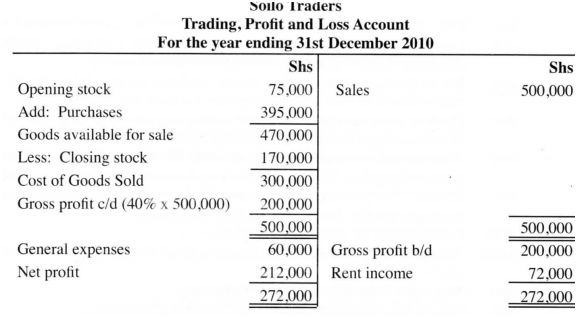
4(a) Advantages of advenising to the consumer include: Consumers become aware of existence of a product and where it can be found. Consumers enjoy high quality goods resulting from competitive advertising. /Producers seek to maintain very high standards of quality. Makes it easy for consumers to choose products from a variety offered in the market based on their advertised quality and contents. Protects consumers from exploitation since they are aware of prices and quality of items and can therefore enforce their rights. Communicates changes about the producer like new product lines. change of name and physical address. This enhances convenience for the customers. Educates the consumers on the proper use of products where advertising messages involve demonstrations of product usage. Entertainment by use of drama/music/plays. – Aiding budget/planning as they are made to know about price and existence of goods. May enjoy lower prices due to competition. Correct misconceptions hence assist in making decisions.
Any 5 @ 2 = 10 marks
4 (b)
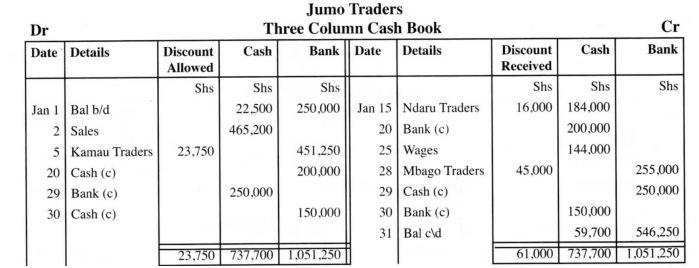
5 . (a) Circumstances under which a trader may use air transport: Perishable nature of goods since they go bad/get damaged. Goods are of high per-unit value since they are prone to theft. Urgency – where goods require to arrive at the destination promptly. Security – where security of goods is of valuable consideration. Where other means of transport are unavailable. Where distance to be covered is too large. Where it is the policy of the business which needs to be followed. Where destination is remote making it inaccessible by other means.
Any 6 @ 2 =12 marks
(b) Ways through which a public limited company may be dissolved include: A resolution by the shareholders to dissolve the company. When there is a unanimous decision by the shareholders to wind up the company during the annual general meeting. Change in the country’s law that renders the activities of the company illegal/ unlawful. When the laws of a country bars certain activities that the company may have been involved in. Inability to repay financial debts on infringement of stakeholders’ rights. Amalgamations/mergers – a company may be dissolved if it combines with another and a new one replaces the one combining/creates a new entity. y Take overs/acquisition/absorption – a company may be dissolved if it is taken over by another/or by the govemment through acquisition of majority shares hence redirection of its activities/loss of identity. Realization of sustained / continuous losses. A company may be dissolved when it makes losses continuously to the extent of not being able to meet its recurrent expenditure/insolvency. Court order for infringing on the law/granted to a complaint raised by stakeholders/acting ultravires. Completion/fulfilment of task/activity/objective (for which the company was formed) hence making its continued existence unnecessary. Failure to commence business within one year after incorporation thus contravening the company’s act.
Any 4 @ 2 = 8 marks
6. (a) The effect of an increase in the supply of a commodity while the demand remains co stant:
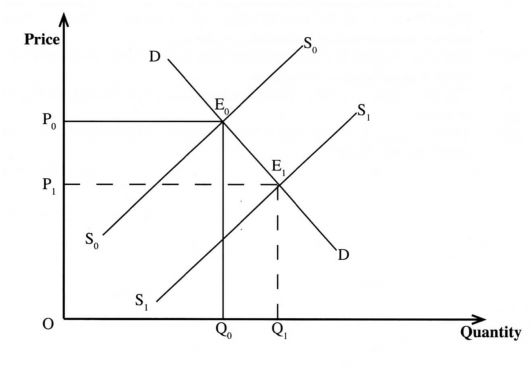
Other factors remaining the same, the price of a commodity will fall from Po to P] as the quantity supplied changes from Q0 to Q‘. This creates a new equilibrium El from E0 as supply curve shifts to the right from SOS” to SIS‘. The increase in supply causes excess supply/surplus. This lowers price to the new equilibrium price oP| and equilibrium quantity oQ[.
Diagram – 16@El = 8 marks
Explanation – 4 @ El = 2 marks
Total = l0 marks
(b) Features of oligopoly include:
(i) Firms are interdependent in decision making. Firms keenly observe each others‘ actions/decision hence acting in any way triggers counter reactions (from other firms).
(ii) Firms deal in products that are homogenous or similar. The products are close substitutes of each other and are only differentiated in terms of aspects like colour/packaging/shapes/pricing/branding.
(iii) Firms may engage in non—price competition/collusive oligopoly. The firms under oligopoly may avoid price wars hence only compete via other means like aggressive advertising/after sales services/market segmentation/fixing quotas.
(iv) Unpredictability of behaviour/uncertainty since finns under oligopoly keep reacting to market changes differently/actions taken by other firms within the market may take others by surprise.
(v) The market is made up of a few large firms since such firms operating under oligopoly tend to have a large capital outlay/make extensive use of modem technology in their production activities/control substancial share of the market.
(vi) There are limiting factors such as large capital investment required to be a player in this market/the level of technology involved may keep off possible entrants into the market/intimidation/collusion.
(vii) Firms may engage in price wars/rivalry/cut throat competition which may lead to survival/collapse of some firms.
(viii) May lead to price rigidity/kinked demand occassioned by fear of other firms‘ reactions.
(ix) There may be price leadership where the dominant firm dictates the market price/rules the market.
Any 5 @ 2 =10 marks

